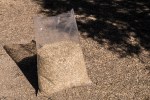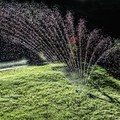Buying guide for Best grass seeds
A green, healthy, lush lawn: every homeowner wants one. Achieving that perfect lawn, however, takes a fair amount of work – most importantly, planting or re-seeding with the right grass seeds for your area, your yard’s conditions, and your lifestyle.
If you aren’t a landscaper or an avid gardener, choosing the right grass seeds can be confusing.
What does “cool season” and “warm season” mean? Is there any hope for that shady area underneath the tree? And what about your kids’ rough-and-tumble games of tag; is there any grass that can survive that?
Your solution might be to grab the first bag of grass seeds you see. After all, grass is grass, right? But before you do that, there are a few things you'll want to consider.
Warm-season vs. cool-season grass seeds
There are many types of grass commonly grown for lawns, but they generally fall into two categories: warm-season grasses and cool-season grasses.
Cool-season grass seeds
Cool-season grasses prefer the milder summer temperatures of the northern states, and they tend to turn brown if temperatures get too hot. They also go dormant during the coldest stretch of winter. Plant cool-season grass seeds in the late summer through early fall.
Some common cool-season grasses include the following.
Kentucky Bluegrass: Kentucky bluegrass has a beautiful blue-green color and fine texture. It tolerates cold and heavy foot traffic and fills in quickly.
Fescue: Fescue grass tolerates shade, drought, and heavy foot traffic.
Perennial Ryegrass: Perennial ryegrass germinates and grows very quickly and tolerates heavy foot traffic. It is very glossy and attractive.
Warm-season grass seeds
Warm-season grasses thrive in the mild winter/hot summer areas of the U.S., including the South, the Southwest, and Southern California. Typically, warm-season grasses go dormant and turn brown over the winter. Plant warm-season grass seeds in the spring.
Some of the most popular warm-season grasses include the following.
St. Augustine: St. Augustine grass tolerates heat, sandy soil, and shade. Its thick growth suppresses weeds.
Bermuda: Bermuda grass tolerates heat, drought, and heavy foot traffic and grows quickly.
Zoysia: Zoysia grass tolerates partial shade, heat, heavy foot traffic, and drought but is a slow grower.
Bahia: Bahia grass is disease-resistant and tolerates sandy soil, heat, drought, salty conditions, and heavy foot traffic. It grows very thick and suppresses weeds.
Centipede: Centipede grass is a slow grower that tolerates some shade and sandy soil. It doesn’t need as much fertilizer as many other types of grass.
Ornamental grass seed is best sown in the spring once the weather starts to warm up. We take time to assess what the best soil is to grow this beautiful flora.
Not all grass seeds are the same. We take time to research every grass type to figure out what environments they would be best suited for.
We investigate the best way to plant grass seeds to provide complete coverage throughout the area they are being planted in.
The best grass seeds come in a variety of different shapes and have different needs. The research we utilize provides the best way to sow grass seeds depending on the soil type, sunlight, and humidity of the area they will be planted in.
Seeds can take a variety of time to sprout depending on the kind of grass that is being planted. We take care to cover all of these factors in our research.
Some grasses are designed to thrive in dry landscapes and others in humidity. We assess each grass to ensure that they work well in a wide variety of climates.
Grass seeds come from a certain type of flower and can even reseed themselves when left alone for long periods of time. We take note of the most hearty grass types in our research.
The best time to sow your seeds can vary depending on what type of climate you live in and the grass you are attempting to plant. We ensure that all of our research covers this aspect of planting grass seeds.
Even grass that thrives in all environments needs to be planted at a certain time of the year. Our research covers when the right time is for each type of grass seed.
Did you know that there are over 10,000 types of grasses? While some may look similar, they all have slight differences. Our research determines the size and shape of the best grass seeds on the market.
Single variety, blended, or mixed seed?
When shopping for grass seeds, it helps to understand the difference between single variety, blended, and mixed seed.
Single variety grass seeds
Single-variety grass seeds, also labeled “straight” grass seeds, contain one type of grass. Generally, only warm-season grasses are sold as single variety seeds. When your lawn is just one type of grass, it looks very even, but it is also more prone to disease.
Blended grass seeds
Blended grass seeds contain several different varieties of the same grass species. This capitalizes on the strengths of each grass variety but still gives a uniform appearance, as different varieties of the same species will usually be close in appearance.
Mixed seed grass seeds
Mixed seed grass seeds contain several different types of grass. Grass seeds labeled for specific conditions, such as “Shade,” “High Traffic,” or “Sun & Shade,” are typically mixed seed. Mixed seeds don’t create a lawn as uniform as a single variety or blended seeds, but they do provide the benefits of different varieties and are generally more disease-resistant. The majority of homeowners plant a mixed seed lawn.
Did you know?
While there are types of grass that are more drought-resistant than others, no grass is truly drought-proof. All types of grass require regular water for the healthiest appearance.
STAFF
BestReviews
How to read the label for grass seeds
Before buying a bag of grass seeds, you need to understand the information on its label.
The package will indicate any special benefits of the seeds, such as heat tolerance, shade tolerance, good for heavy foot traffic, or weed resistance.
If you are buying a seed mix or blend, check out the percentages of each included variety. If the varieties aren’t listed, pass on that brand.
The instructions should state how many square feet the grass seeds will cover. Be sure you know how large your lawn area is before you buy.
Check out the germination rate of the seeds, which means how many seeds you can reasonably expect to actually sprout. There is no such thing as a 100% germination rate for any type of seed, but a germination rate of 75% or better is ideal.
Any bag of grass seeds will have a certain amount of inert filler, such as dirt or chaff. However, the filler should be less than 2%.
The label will indicate the percentage of weed seeds – these creep in no matter what brand you choose – but that rate should not be more than 0.5%.
Check the grass seeds’ expiration date. Don’t buy seeds that are past that date; the germination rate falls sharply beyond that point.
Consider your specific grass seed needs
Once you understand the basics, it’s time to get specific. Let’s take a look at what to consider when deciding which grass seeds are right for your yard.
How much sun does your yard get? Look for a seed variety or mix that is full-sun tolerant if your yard gets six hours or more of direct sunlight each day.
Are there any shady spots underneath trees? Or is the whole yard shaded? It’s admittedly tough to grow grass in a heavily shaded area, but there are varieties that tolerate partial shade, meaning just a few hours of sunlight per day.
Do you have dogs? Dogs might be man’s best friend, but they are definitely not your lawn’s good buddy. While there are varieties of grass that tolerate dog urine better than others, if you really want your lawn to look nice, consider training your pooch to use a small patch of artificial turf or a gravel area fenced off just for him.
Does your lawn get heavy foot traffic? While any variety of lawn grass should tolerate at least light foot traffic, some varieties are much more forgiving than others. If you have kids that play outdoors or you like to host neighborhood football games, you’ll want a grass blend specifically geared towards heavy use.
Are you just patching up holes or damage? If your lawn is mostly in good shape, but you want to fill in a few small holes or damaged spots, you’ll find a wide range of seed blends mixed with fertilizer to quickly cover the spot with new grass.
Did you know?
Most varieties of grass need at least one inch of water per week or more if it’s especially hot or windy. If rain doesn’t do the job for you, you’ll need to supplement with sprinklers or a hose.
STAFF
BestReviews
How much do grass seeds cost?
The price of grass seeds depends on the size of the bag, the type of seed, any particular added materials such as fertilizer, and the brand.
But as a general rule, you should expect to pay $10 to $25 for a good-quality, three-pound bag of grass seeds.
Caution
Bargain bags of grass seeds often have high levels of weed seeds and low rates of germination. Look for good-quality grass seeds from a company that specializes in lawn care for the best results.
STAFF
BestReviews
Tips for planting grass seeds
You’ve purchased the right grass seeds for your area, your specific yard, and your lifestyle. Now it’s time to plant.
Work the soil in the area to be planted. Break up clods, remove rocks, and pull any weeds or undesired growth.
Add compost or fertilizer to the soil, and mix it in thoroughly.
Water the area you’ll be planting, then wait a day or two before seeding.
If you’re seeding a small area, go ahead and use a hand broadcast spreader to spread the seed. If it’s a large lawn, however, buy or rent a push lawn spreader for even sowing.
Follow the directions on the package regarding how thickly to spread the seeds. Make two passes over the area you’re planting: one vertically and one horizontally.
Cover the seeds with straw or a very light layer of compost after sowing. Then rope off or put barriers around the area to prevent foot traffic.
Water the planted area lightly, and if it doesn’t rain, continue to lightly water the area daily until you see growth. Depending on the type of grass, this could be anywhere from a few days to a week or more.
Once your grass has sprouted, cut back on the watering but don’t let the soil dry out completely.
Once the new turf is around three inches high, it’s time to mow. At this point, the grass should be able to tolerate light foot traffic.
FAQ
Q. Can I spread grass seeds over an existing lawn?
A. Many people in warm winter areas overseed their lawns with annual rye or similar “temporary” grass seeds to keep the lawn looking good through winter. However, if you are planting a new lawn or trying to reinvigorate a very damaged, thin, or unhealthy stretch of grass, take the time to prepare the soil thoroughly, which means removing any existing grass, weeds, or other plants, before sowing the new seeds.
Q. Is it a good idea to buy grass seeds with fertilizer already included?
A. While you’ll pay more for pre-fertilized grass seeds, you’ll save time. These ready-to-go bags make the job of planting much easier. Some even include weed killers for the maximum in convenience.
Q. When should I fertilize my grass?
A. It depends on where you live. In cold winter areas, apply lawn fertilizer in the early fall or late spring. If you live in a mild winter area, feed your grass in the early spring.

























































